Snapper RE 200 User Manual
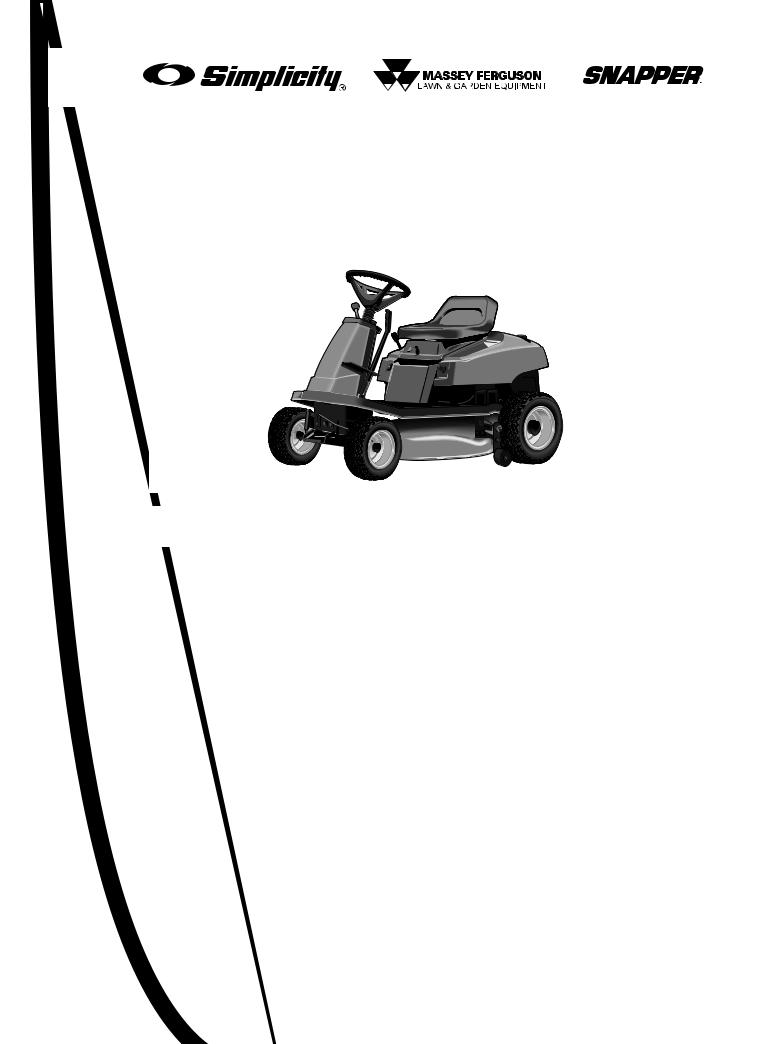
OPERATOR’S
MANUAL
Coronet / 2400 / RE 200 Series
13HP Hydro Riders |
30” Mower Decks |
|||
Mfg. No. |
Description |
Mfg. No. |
Description |
|
1694610 |
Coronet, 13HP |
1692543 |
30” Mower Deck |
|
1694612 |
Coronet, 13HP (CE) |
1694053 |
30” Mower Deck |
|
1694613 |
2413H, 13HP |
1694511 |
30” Mower Deck (CE) |
|
1694614 |
2413H, 13HP (CE) |
1694537 |
30” Mower Deck |
|
1694615 |
RE1330, 13HP |
34” Mower Decks |
||
1694616 |
RE1330, 13HP (CE) |
|||
1695508 |
Coronet, 13HP |
Mfg. No. |
Description |
|
1695509 |
RE1330, 13HP |
|||
1692545 |
34” Mower Deck |
|||
2690244 |
Coronet, 13HP & 30” Mower |
|||
1694191 |
34” Mower Deck |
|||
2690246 |
Coronet, 13HP & 30” Mower (CE) |
|||
|
|
|||
2690247 |
2413H, 13HP & 30” Mower |
|
|
|
2690248 |
2413H, 13HP & 30” Mower (CE) |
|
|
|
2690249 |
RE1330, 13HP & 30” Mower |
|
|
|
2690250 |
RE1330, 13HP & 30” Mower (CE) |
|
|
|
2690800 |
Coronet, 13HP & 30” Mower |
|
|
|
2690801 |
RE1330, 13HP & 30” Mower |
|
|
|
16HP Hydro Riders |
|
|
||
Mfg. No. |
Description |
|
|
|
1694611 |
Coronet, 16HP |
|
|
|
1695510 |
Coronet, 16HP |
|
|
|
2690245 |
Coronet, 16HP & 34” Mower |
|
|
|
2690802 |
Coronet, 16HP & 34” Mower |
|
|
|
1726959
Revision E
Rev. Date 10/2008
TP10004528
THIS PAGE INTENTIONALLY BLANK
(FOR PLACEMENT ONLY - DO NOT PRINT)
2

Table of Contents
Safety Rules & Information................................. |
4 |
Identification Numbers........................................ |
9 |
Safety Decals ..................................................... |
10 |
Features & Controls .......................................... |
12 |
Control Functions.................................................. |
12 |
Safety Interlock System ........................................ |
14 |
Operating the Rider........................................... |
14 |
General ................................................................. |
14 |
Adding Fuel........................................................... |
14 |
Checks Before Starting ......................................... |
14 |
Brake Pedal Operation.......................................... |
15 |
Starting The Engine .............................................. |
15 |
Selecting Ground & Engine Speed ....................... |
16 |
Stopping the Rider ................................................ |
16 |
Operating the Mower ............................................ |
16 |
Mowing in Reverse ............................................... |
17 |
Attachment Operation in Reverse......................... |
17 |
Pushing the Rider by Hand .................................. |
17 |
Mower Removal and Installation........................... |
18 |
Storage ................................................................. |
19 |
Regular Maintenance ........................................ |
20 |
Maintenance Schedule ......................................... |
20 |
Checking Tire Pressures....................................... |
20 |
Raising the Seat Deck .......................................... |
21 |
Adding Fuel........................................................... |
21 |
Fuel Filter .............................................................. |
21 |
Oil & Filter Change................................................ |
21 |
Check / Change Air FIlter...................................... |
21 |
Replace Spark Plug .............................................. |
21 |
Lubrication ............................................................ |
22 |
Battery Maintenance ............................................. |
23 |
Cleaning the Battery and Cables .................. |
23 |
Lubricate Rear Axle Shafts ................................... |
23 |
Servicing the Mower Blades ................................. |
24 |
Troubleshooting, Adjustments & Service ....... |
25 |
Troubleshooting the Rider..................................... |
25 |
Troubleshooting the Mower .................................. |
26 |
Seat Adjustment.................................................... |
27 |
Steering Gear Adjustment..................................... |
27 |
Steering Wheel Adjustment .................................. |
27 |
Brake Adjustment.................................................. |
28 |
Blade Brake Adjustment ....................................... |
28 |
Mower Adjustments .............................................. |
29 |
Battery Charging ................................................... |
31 |
Rider Drive Belt Replacement............................... |
32 |
Mower Belt Replacement...................................... |
32 |
Specifications .................................................... |
33 |
Parts & Accessories.......................................... |
34 |
NOTE: In this manual, “left” and “right” are referred to as seen from the operating position.
3
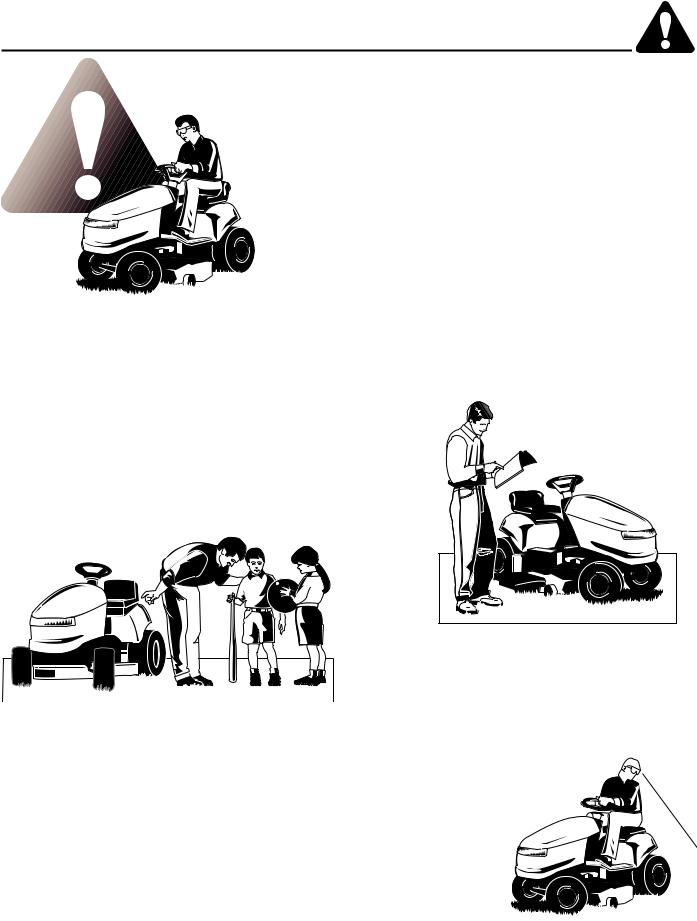
Safety Rules & Information
Operating Safety
Congratulations on purchasing a superior-quality piece of lawn and garden equipment. Our products are designed and manufactured to meet or exceed all industry standards for safety.
Power equipment is only as safe as the operator. If it is misused, or not properly maintained, it can be dangerous! Remember, you are responsible for your safety and that of those around you.
Use common sense, and think through what you are doing. If you are not sure that the task you are about to perform can be safely done with the equipment you have chosen, ask a professional: contact your local authorized dealer.
Read the Manual
The operator’s manual contains important safety information you need to be aware of
BEFORE you operate your unit as well as DURING operation.
Safe operating techniques, an explanation of the product’s features and controls, and maintenance information is included to help you get the most out of your equipment investment.
Be sure to completely read the Safety Rules and Information found on the following pages. Also completely read the Operation section.
Children
Tragic accidents can occur with children. Do not allow them anywhere near the area of operation. Children are often attracted to the unit and mowing activity. Never assume that children will remain where you last saw them. If there is a risk that children may enter the area where you are mowing, have another responsible adult watch them.
DO NOT GIVE CHILDREN RIDES ON THIS UNIT! This encourages them to come near the unit in the future while it is running, and they could be seriously hurt. They may then approach the unit for a ride when you are not expecting it, and you may run over them.
Reverse
Do not mow in reverse unless absolutely necessary. Always look  down and behind before and
down and behind before and 


 while traveling in reverse
while traveling in reverse 


even with the mower 

 blades disengaged.
blades disengaged. 


4
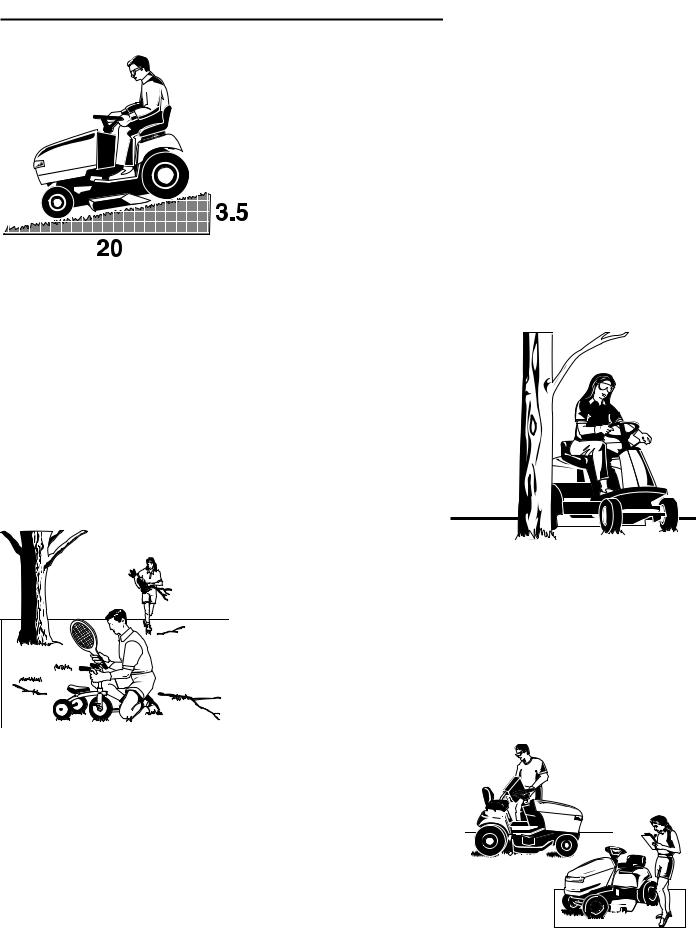
Safety Rules and Information
Slope Operation
You could be seriously injured or even killed if you use this unit on too steep an incline. Using the unit on a slope that is too steep or where you don’t have adequate traction can cause you to lose control or roll over.
A good rule of thumb is to not operate on any slope you cannot back up (in 2-wheel drive mode). You should not operate on inclines with a slope greater than a 3.5 foot rise over a 20 foot length. Always drive up and down slopes: never cross the face.
Also note that the surface you are driving on can greatly impact stability and control. Wet grass or icy pavement can seriously affect your ability to control the unit.
If you feel unsure about operating the unit on an incline, don’t do it. It’s not worth the risk.
Moving Parts
This equipment has many moving parts that can injure you or someone else. However, if you are seated in the seat properly, and follow all the rules in this book, the unit is safe to operate.
The mower deck has spinning mower blades that can amputate hands and feet.
Do not allow anyone near the equipment while it is running!
To help you, the operator, use this equipment safely, it is equipped with an operator-present safety system. Do NOT attempt to alter or bypass the system. See your dealer immediately if the system does not pass all the safety interlock system tests found in this manual.
Thrown Objects
This unit has spinning mower blades. These blades can pick up and throw debris that could seriously injure a bystander. Be sure to clean up the area to be mowed BEFORE you start mowing.
Do not operate this unit without the entire grass catcher or discharge guard (deflector) in place.
Also, do not allow anyone in the area while the unit is running! If someone does enter the area, shut the unit off immediately until they leave.
Fuel and Maintenance
Gasoline is extremely flammable. Its vapors are also extremely flammable and can travel to distant ignition sources. Gasoline must only be used as a fuel, not as a solvent or cleaner. It should never be stored any place where its vapors can build up or travel to an ignition source like a pilot light. Fuel belongs in an approved, plastic, sealed gas can, or in the tractor fuel tank with the cap securely closed. Spilled fuel needs to be cleaned up immediately.
Proper maintenance is critical to the safety and performance of your unit. Be sure to perform the maintenance procedures listed in this manual, especially periodically testing the safety system.
5
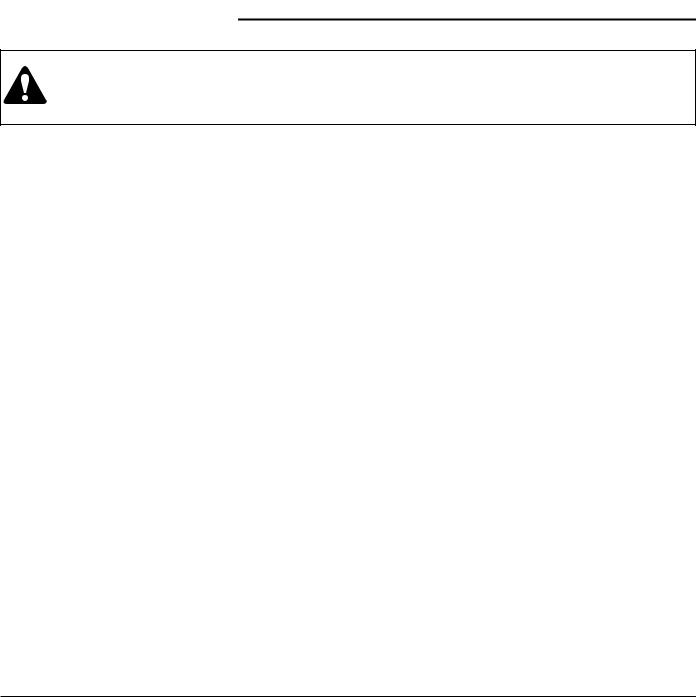
Safety Rules & Information
Read these safety rules and follow them closely. Failure to obey these rules could result in loss of control of unit, severe personal injury or death to you, or bystanders, or damage to property or equipment.
This mowing deck is capable of amputating hands and feet and throwing objects.
The triangle  in text signifies important cautions or warnings which must be followed.
in text signifies important cautions or warnings which must be followed.
GENERAL OPERATION
1.Read, understand, and follow all instructions in the manual and on the unit before starting.
2.Do not put hands or feet near rotating parts or under the machine. Keep clear of the discharge opening at all times.
3.Only allow responsible adults, who are familiar with the instructions, to operate the unit (local regulations can restrict operator age).
4.Clear the area of objects such as rocks, toys, wire, etc., which could be picked up and thrown by the blade(s).
5.Be sure the area is clear of other people before mowing. Stop the unit if anyone enters the area.
6.Never carry passengers.
7.Do not mow in reverse unless absolutely necessary. Always look down and behind before and while travelling in reverse.
8.Never direct discharge material toward anyone. Avoid discharging material against a wall or obstruction. Material may ricochet back toward the operator. Stop the blade(s) when crossing gravel surfaces.
9.Do not operate the machine without the entire grass catcher, discharge guard (deflector), or other safety devices in place.
10.Slow down before turning.
11.Never leave a running unit unattended. Always disengage the PTO, set parking brake, stop engine, and remove keys before dismounting.
12.Disengage blades (PTO) when not mowing. Shut off engine and wait for all parts to come to a complete stop before cleaning the machine, removing the grass catcher, or unclogging the discharge guard.
13.Operate the machine only in daylight or good artificial light.
14.Do not operate the unit while under the influence of alcohol or drugs.
15Watch for traffic when operating near or crossing roadways.
16.Use extra care when loading or unloading the unit into a trailer or truck.
17.Always wear eye protection when operating this unit.
18.Data indicates that operators, age 60 years and above, are involved in a large percentage of power equipment-related injuries. These operators should evaluate their ability to operate the equipment safely enough to protect themselves and others from injury.
19.Follow the manufacturer’s recommendations for wheel weights or counterweights.
20.Keep in mind the operator is responsible for accidents occurring to other people or property.
21.All drivers should seek and obtain professional and practical instruction.
22.Always wear substantial footwear and trousers. Never operate when barefoot or wearing sandals.
23.Before using, always visually check that the blades and blade hardware are present, intact, and secure. Replace worn or damaged parts.
24.Disengage attachments before: refueling, removing an attachment, making adjustments (unless the adjustment can be made from the operator’s position).
25.When the machine is parked, stored, or left unattended, lower the cutting means unless a positive mechanical lock is used.
26.Before leaving the operator’s position for any reason, engage the parking brake (if equipped), disengage the PTO, stop the engine, and remove the key.
27.To reduce fire hazard, keep the unit free of grass, leaves, & excess oil. Do not stop or park over dry leaves, grass, or combustible materials.
28.It is a violation of California Public Resource Code Section 4442 to use or operate the engine on or near any forest-covered, brush-covered, or grass-covered land unless the exhaust system is equipped with a spark arrester meeting any applicable local or state laws. Other states or federal areas may have similar laws.
TRANSPORTING AND STORAGE
1.When transporting the unit on an open trailer, make sure it is facing forward, in the direction of travel. If the unit is facing backwards, wind lift could damage the unit.
2.Always observe safe refueling and fuel handling practices when refueling the unit after transportation or storage.
3.Never store the unit (with fuel) in an enclosed poorly ventilated structure. Fuel vapors can travel to an ignition source (such as a furnace, water heater, etc.) and cause an explosion. Fuel vapor is also toxic to humans and animals.
4.Always follow the engine manual instructions for storage preparations before storing the unit for both short and long term periods.
5.Always follow the engine manual instructions for proper start-up procedures when returning the unit to service.
6.Never store the unit or fuel container inside where there is an open flame or pilot light, such as in a water heater. Allow unit to cool before storing.
6
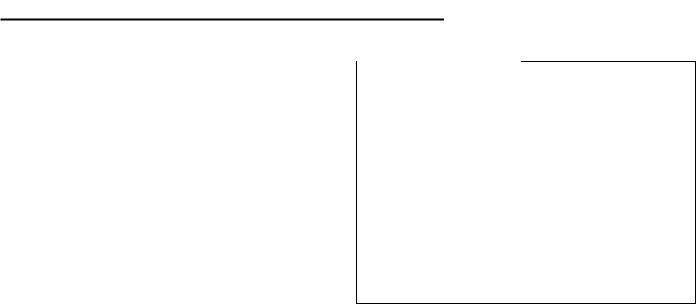
SLOPE OPERATION
Slopes are a major factor related to loss-of-control and tipover accidents, which can result in severe injury or death. Operation on all slopes requires extra caution. If you cannot back up the slope or if you feel uneasy on it, do not operate on it.
Control of a walk-behind or ride-on machine sliding on a slope will not be regained by the application of the brake. The main reasons for loss of control are: insufficient tire grip on the ground, speed too fast, inadequate braking, the type of machine is unsuitable for its task, lack of awareness of the ground conditions, incorrect hitching and load distribution.
1.Mow up and down slopes, not across.
2.Watch for holes, ruts, or bumps. Uneven terrain could overturn the unit. Tall grass can hide obstacles.
3.Choose a slow speed so that you will not have to stop or change speeds while on the slope.
4.Do not mow on wet grass. Tires may loose traction.
5.Always keep unit in gear especially when traveling down slopes. Do not shift to neutral and coast downhill.
6.Avoid starting, stopping, or turning on a slope. If tires lose traction, disengage the blade(s) and proceed slowly straight down the slope.
7.Keep all movement on slopes slow and gradual. Do not make sudden changes in speed or direction, which could cause the machine to rollover.
8.Use extra care while operating machines with grass catchers or other attachments; they can affect the stability of the unit. Do not use on steeps slopes.
9.Do not try to stabilize the machine by putting your foot on the ground (ride-on units).
10.Do not mow near drop-offs, ditches, or embankments. The mower could suddenly turn over if a wheel is over the edge of a cliff or ditch, or if an edge caves in.
11.Do not use grass catchers on steep slopes.
12.Do not mow slopes you cannot back up them.
13.See your authorized dealer/retailer for recommendations of wheel weights or counterweights to improve stability.
14.Remove obstacles such as rocks, tree limbs, etc.
15.Use slow speed. Tires may lose traction on slopes even through the brakes are functioning properly.
16.Do not turn on slopes unless necessary, and then, turn slowly and gradually downhill, if possible.
Safety Rules and Information
 WARNING
WARNING
Never operate on slopes greater than 17.6 percent (10°) which is a rise of 3-1/2 feet (106 cm) vertically in 20 feet (607 cm) horizontally.
When operating on slopes use additional wheel weights or counterweights. See your dealer/retailer to determine which weights are available and appropriate for your unit.
Select slow ground speed before driving onto slope. In addition to front weights, use extra caution when operating on slopes with rear-mounted grass catchers.
Mow UP and DOWN the slope, never across the face, use caution when changing directions and DO NOT START OR STOP ON SLOPE.
CHILDREN
Tragic accidents can occur if the operator is not alert to the presence of children. Children are often attracted to the unit and the mowing activity. Never assume that children will remain where you last saw them.
1.Keep children out of the mowing area and under the watchful care of another responsible adult.
2.Be alert and turn unit off if children enter the area.
3.Before and during reverse operation, look behind and down for small children.
4.Never carry children, even with the blade(s) off. They may fall off and be seriously injured or interfere with safe unit operation. Children who have been given rides in the past may suddenly appear in the mowing area for another ride and be run over or backed over by the machine.
5.Never allow children to operate the unit.
6.Use extra care when approaching blind corners, shrubs, trees, or other objects that may obscure vision.
EMISSIONS
1.Engine exhaust from this product contains chemicals known, in certain quantities, to cause cancer, birth defects, or other reproductive harm.
2.Look for the relevant Emissions Durability Period and Air Index information on the engine emissions label.
TOWED EQUIPMENT (RIDE-ON UNITS)
1.Tow only with a machine that has a hitch designed for towing. Do not attach towed equipment except at the hitch point.
2.Follow the manufacturer’s recommendations for weight limit for towed equipment and towing on slopes.
3.Never allow children or others in or on towed equipment.
4.On slopes, the weight of the towed equipment may cause loss of traction and loss of control.
5.Travel slowly and allow extra distance to stop.
6.Do not shift to neutral and coast down hill.
IGNITION SYSTEM
1.This spark ignition system complies with Canadian standard ICES-002.
7

Safety Rules & Information
SERVICE AND MAINTENANCE
Safe Handling of Gasoline
1.Extinguish all cigarettes, cigars, pipes, and other sources of ignition.
2.Use only approved gasoline containers.
3.Never remove the gas cap or add fuel with the engine running. Allow the engine to cool before refueling.
4.Never fuel the machine indoors.
5.Never store the machine or fuel container where there is an open flame, spark, or pilot light such as near a water heater or other appliance.
6.Never fill containers inside a vehicle or on a truck bed with a plastic bed liner. Always place containers on the ground away from your vehicle before filling.
7.Remove gas-powered equipment from the truck or trailer and refuel it on the ground. If this is not possible, then refuel such equipment on a trailer with a portable container, rather than from a gasoline dispenser nozzle.
8.Keep nozzle in contact with the rim of the fuel tank or container opening at all times until fueling is complete. Do not use a nozzle lock-open device.
9.If fuel is spilled on clothing, change clothing immediately.
10.Never over-fill the fuel tank. Replace gas cap and tighten securely.
11.Use extra care in handling gasoline and other fuels. They are flammable and vapors are explosive.
12.If fuel is spilled, do not attempt to start the engine but move the machine away from the area of spillage and avoid creating any source of ignition until fuel vapors have dissipated.
13.Replace all fuel tank caps and fuel container caps securely.
Service & Maintenance
1.Never run the unit in an enclosed area where carbon monoxide fumes may collect.
2.Keep nuts and bolts, especially blade attachment bolts, tight and keep equipment in good condition.
3.Never tamper with safety devices. Check their proper operation regularly and make necessary repairs if they are not functioning properly.
4.Keep unit free of grass, leaves, or other debris buildup. Clean up oil or fuel spillage. and remove any fuelsoaked debris. Allow machine to cool before storage.
5.If you strike an object, stop and inspect the machine. Repair, if necessary, before restarting.
6.Never make adjustments or repairs with the engine running.
7.Check grass catcher components and the discharge guard frequently and replace with manufacturer’s recommended parts, when necessary.
8.Mower blades are sharp. Wrap the blade or wear gloves, and use extra caution when servicing them.
9.Check brake operation frequently. Adjust and service as required.
10.Maintain or replace safety and instructions labels, as necessary.
11.Do not remove the fuel filter when the engine is hot as spilled gasoline may ignite. Do not spread fuel line clamps further than necessary. Ensure clamps grip hoses firmly over the filter after installation.
12.Do not use gasoline containing METHANOL, gasohol containing more than 10% ETHANOL, gasoline additives, or white gas because engine/fuel system damage could result.
13.If the fuel tank must be drained, it should be drained outdoors.
14.Replace faulty silencers/mufflers.
15.Maintain or replace safety and instruction labels as necessary.
16.Use only factory authorized replacement parts when making repairs.
17.Always comply with factory specifications on all settings and adjustments.
18.Only authorized service locations should be utilized for major service and repair requirements.
19.Never attempt to make major repairs on this unit unless you have been properly trained. Improper service procedures can result in hazardous operation, equipment damage and voiding of manufacturer’s warranty.
20.On multiple blade mowers, take care as rotating one blade can cause other blades to rotate.
21.Do not change engine governor settings or overspeed the engine. Operating the engine at excessive speed can increase the hazard of personal injury.
22.Disengage drive attachments, stop the engine, remove the key, and disconnect the spark plug wire(s) before: clearing attachment blockages and chutes, performing service work, striking an object, or if the unit vibrates abnormally. After striking an object, inspect the machine for damage and make repairs before restarting and operating the equipment.
23.Never place hands near the moving parts, such as a hydro pump cooling fan, when the tractor is running. (Hydro pump cooling fans are typically located on top of the transaxle).
24.Units with hydraulic pumps, hoses, or motors: WARNING: Hydraulic fluid escaping under pressure may have sufficient force to penetrate skin and cause serious injury. If foreign fluid is injected into the skin it must be surgically removed within a few hours by a doctor familiar with this form of injury or gangrene may result. Keep body and hands away from pin holes or nozzles that eject hydraulic fluid under high pressure. Use paper or cardboard, and not hands, to search for leaks. Make sure all hydraulic fluid connections are tight and all hydraulic hoses and lines are in good condition before applying pressure to the system. If leaks occur, have the unit serviced immediately by your authorized dealer.
25.WARNING: Stored energy device. Improper release of springs can result in serious personal injury. Springs should be removed by an authorized technician.
26.Models equipped with an engine radiator: WARNING: Stored energy device. To prevent serious bodily injury from hot coolant or steam blow-out, never attempt to remove the radiator cap while the engine is running. Stop the engine and wait until it is cool. Even then, use extreme care when removing the cap.
8
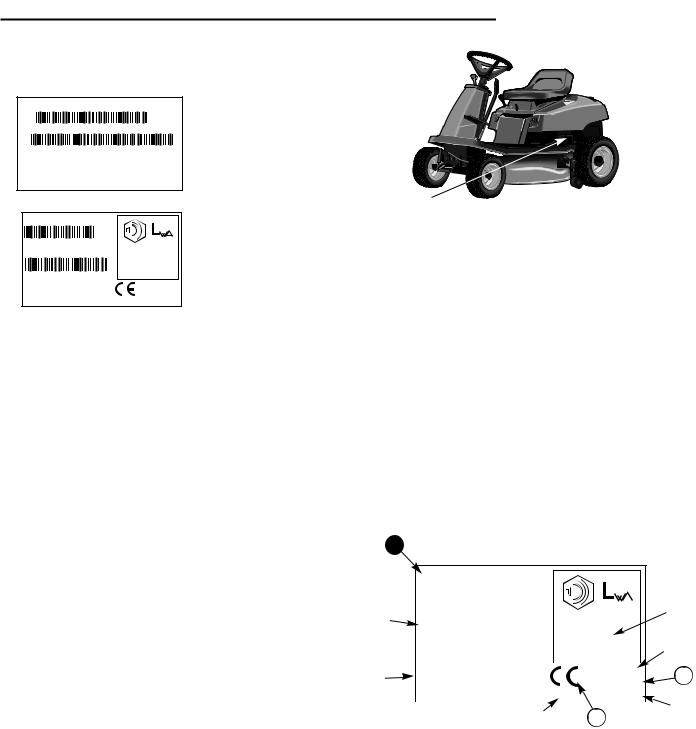
Identification Numbers
SA |
|
|
|
Product Identification Tag |
|
||
Model / Modéle / |
|
xxxxxxxx |
North American / |
Model |
CE Models |
||
Serial / Sèrie / Serie |
P |
||
|
xxxxxxxxxx |
|
|
|
|
L |
|
Briggs & Stratton Power Products Group, L.L.C. |
|||
Milwaukee, WI 53201EUSA |
|||
S |
|
|
|
Part No. xxxxxxx |
|
|
|
xxxxxxxxxxxxxxxA |
|
|
CE Models |
|
|
(Only) |
|
M |
|
||
Serial No. xxxxxxxxxx |
|
|
|
PL |
|
||
xxxxxxxxxxxxxxxxxxxxxxx |
xxxdB |
||
xxxxxxxxxxxxxxxxxxxxxxx |
E20xx |
kg: xxx |
|
xxxxxxxxxxxxxxxxxxxxxxx |
kW: x.xx |
||
xxxxxxxxxxxxxxxxxxxxxxx |
xxxx max |
||
When contacting your authorized dealer for replacement parts, service, or information you MUST have these numbers.
Record your model name/number, manufacturer’s identification numbers, and engine serial numbers in the space provided for easy access. These numbers can be found in the locations shown.
NOTE: For location of engine identification numbers, refer to the engine owner’s manual.
CE IDENTIFICATION TAG MARKINGS
A.Manufacturer’s Identification Number
B.Manufacturer’s Serial Number
C.Power Rating in Kilowatts
D.Maximum Engine Speed in Rotations per Minute
E.Manufacturer’s Name and Address
F.Year of Manufacture
G.CE Compliance Logo
H.Mass of Unit in Kilograms
I.Guaranteed Sound Power in Decibels
Identification Numbers
Tractor ID Tag
PRODUCT |
REFERENCE DATA |
|
|
|
|
Model Description Name/Number |
|
|
|
|
|
Unit MFG Number |
|
Unit SERIAL Number |
|
|
|
Mower Deck MFG Number |
|
Mower Deck SERIAL Number |
|
|
|
Dealer Name |
|
Date Purchased |
|
|
|
ENGINE REFERENCE DATA |
||
|
|
|
Engine Make |
|
Engine Model |
|
|
|
Engine Type/Spec |
|
Engine Code/Serial Number |
|
|
|
A
Part No. xxxxxxx
|
|
|
|
|
|
|
|
|
|
|
|
|
|
|
|
|
|
|
|
|
|
|
|
|
|
|
|
|
|
|
|
|
xxxxxxxxxxxxxxx |
xxxdB |
|
|
|
I |
|
||||||||||||||||
|
B |
|
|
|
|||||||||||||||||||||||
|
|
|
|
|
|
|
|
||||||||||||||||||||
|
|
|
Serial No. xxxxxxxxxx |
|
|
|
|
|
|||||||||||||||||||
|
|
|
|
|
|
|
|
|
|
||||||||||||||||||
|
|
|
|
|
|
|
|
|
|
|
|
|
|
|
|
|
|
|
|
|
|
|
|||||
|
|
|
|
|
|
|
|
|
|
|
|
|
|
|
|
|
|
|
|
H |
|
||||||
|
|
|
|
|
xxxxxxxxxxxxxxxxxxxxxxx |
||||||||||||||||||||||
|
|
|
|
|
|
|
|
|
|
||||||||||||||||||
|
|
|
|
|
|
|
|
|
|
||||||||||||||||||
|
|
|
|
|
xxxxxxxxxxxxxxxxxxxxxxx |
|
|
kg: xxx |
|
|
C |
||||||||||||||||
|
E |
|
|
|
|
|
|
|
|||||||||||||||||||
|
|
|
xxxxxxxxxxxxxxxxxxxxxxx |
|
|
kW: x.xx |
|
|
|||||||||||||||||||
|
|
|
|
|
|
|
|
|
|
|
|||||||||||||||||
|
|
|
|
|
xxxxxxxxxxxxxxxxxxxxxxx |
20xx xxxx max |
|
|
|
|
|||||||||||||||||
|
|
|
|
|
|
|
D |
||||||||||||||||||||
|
|
|
|
|
|
|
|
|
|
|
|
|
|
|
|
|
|
|
|
|
|
|
|
|
|
||
|
|
|
|
|
|
|
|
|
|
|
|
|
|
|
|
F |
|
|
|
G |
|
|
|||||
|
|
|
|
|
|
|
|
|
|
|
|
|
|
|
|
|
|
|
|
|
|
|
|||||
|
|
|
|
|
|
|
|
|
|
|
|
|
|
|
|
|
|
|
|
|
|
||||||
|
|
|
|
|
|
|
|
|
|
|
|
|
|
|
|
|
|
|
|
|
|
|
|
|
|
|
|
9
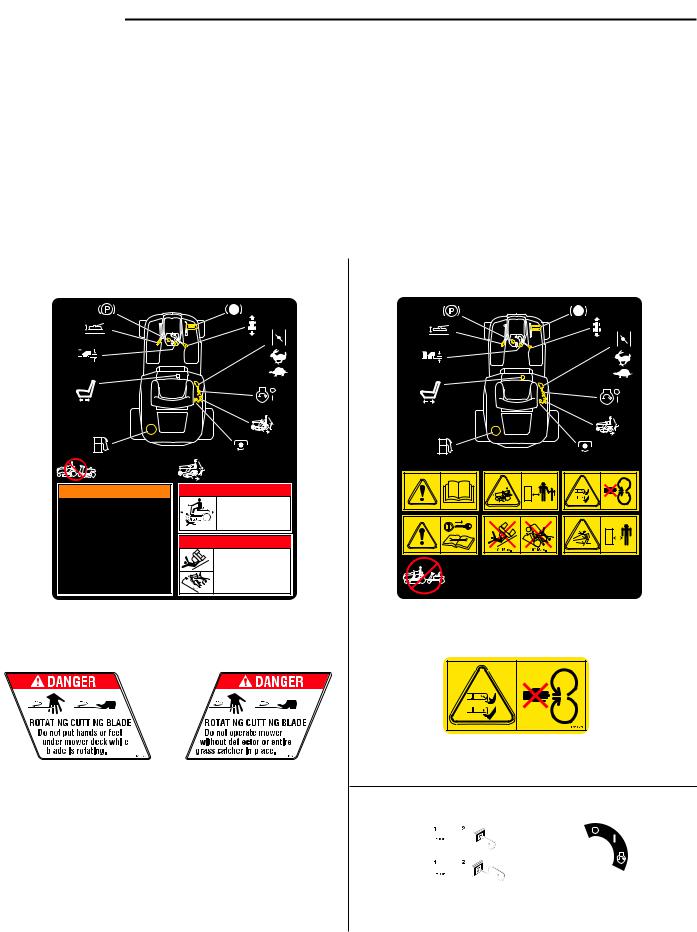
Safety Decals
SAFETY DECALS
This unit has been designed and manufactured to provide you with the safety and reliability you would expect from an industry leader in outdoor power equipment manufacturing.
Although reading this manual and the safety instructions it contains will provide you with the necessary basic knowledge to operate this equipment safely and effectively, we have placed several safety labels on the unit to remind you of this important information while you are operating your unit.
All DANGER, WARNING, CAUTION and instructional messages on your rider and mower should be carefully read and obeyed. Personal bodily injury can result when these instructions are not followed. The information is for your safety and it is important! The safety decals below are on your rider and mower.
If any of these decals are lost or damaged, replace them at once. See your local dealer for replacements.
These labels are easily applied and will act as a constant visual reminder to you, and others who may use the equipment, to follow the safety instructions necessary for safe, effective operation.
NORTH AMERICAN MODELS
|
RMO™ System: |
DO NOT TOW RIDER! |
This product is equipped with the RMO system. |
Refer to the operator's manual for a full explanation |
|
Damage may result to transmission. |
of the RMO system and for important safety messages. |
 WARNING
WARNING
AVOID SERIOUS INJURY OR DEATH
•READ OPERATOR'S MANUAL(S).
•KNOW LOCATION AND FUNCTION OF ALL CONTROLS.
•KEEP SAFETY DEVICES (GUARDS, SHIELDS, & SWITCHES) IN PLACE AND WORKING.
•REMOVE OBJECTS THAT COULD BE THROWN BY THE BLADE.
•DO NOT MOW WHEN CHILDREN OR OTHERS ARE AROUND.
•NEVER CARRY CHILDREN EVEN WITH BLADES OFF.
•LOOK DOWN AND BEHIND BEFORE AND WHILE BACKING.
•AVOID SUDDEN TURNS.
•IF YOU CANNOT BACK UP A HILL, DO NOT OPERATE ON IT.
•GO UP AND DOWN SLOPES, NOT ACROSS.
•IF MACHINE STOPS GOING UPHILL, STOP BLADE AND BACK DOWN SLOWLY.
•BE SURE BLADE(S) AND ENGINE ARE STOPPED BEFORE PLACING HANDS OR FEET NEAR BLADE(S).
•WHEN LEAVING MACHINE, SHUT OFF ENGINE, REMOVE KEY, AND SET PARKING BRAKE.
 DANGER
DANGER
ROTATING BLADES CUT OFF
ARMS AND LEGS
STOP MOWER WHEN CHILDREN
ARE NEAR.
NO RIDERS — THEY FALL OFF.
 DANGER
DANGER
OPERATING ON SLOPES CAN
BE DANGEROUS
SEE OPERATOR'S MANUAL.
IF YOU CANNOT BACK-UP
A HILL, DO NOT DRIVE ON IT.
1726956
Decal - Operating Instructions, North American
Models, Part No. 1726956
|
|
|
|
|
|
|
|
|
|
|
|
|
|
|
|
|
|
|
|
|
|
|
|
|
|
|
|
|
|
|
|
|
|
|
|
|
|
|
|
|
|
|
|
|
|
|
|
|
|
|
|
|
|
|
|
|
|
|
|
|
|
|
|
|
|
|
|
|
|
|
|
|
|
|
|
|
|
|
|
|
|
|
|
|
|
|
|
|
|
|
|
|
|
|
|
|
|
|
|
|
|
|
|
|
|
|
|
|
|
|
|
|
|
|
|
|
|
|
|
|
|
|
|
|
|
|
|
|
|
|
|
|
|
|
|
Decal - Danger, Side- |
Decal - Danger, Side |
|||||||||||||||
Discharge Models |
Discharge Models |
|||||||||||||||
Part No. 1704276 |
Part No. 1704277 |
|||||||||||||||
CE MODELS
1726957
Decal - Operating Instructions, CE Models,
Part No. 1726957
Decal - Danger, Rotating Blades
Part No. 1720389
ALL MODELS
|
1726341 |
|
Decal - Ignition Switch |
Decal - Transmission Release |
Positions |
||
Part No. 1726341 |
Part No. 1722806 |
||
10
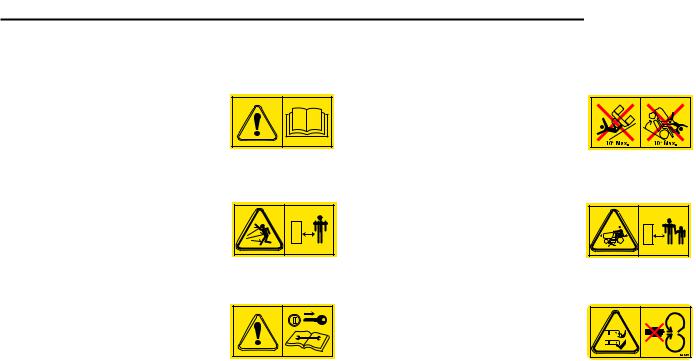
SAFETY ICONS
Warning: Read Operator’s
Manual.
Read and understand the Operator’s Manual before using this machine.
Danger: Thrown Objects.
This machine is capable of throwing objects and debris. Keep bystanders away.
Warning: Remove Key Before
Servicing.
Remove the key and consult technical literature before performing repairs or maintenance.
Safety Icons
Danger: Machine Rollover.
Do not use this machine on slopes greater than 10°.
Danger: Dismemberment.
This machine can amputate limbs. Keep bystanders and children away when engine is running.
Danger: Dismemberment.
This mower deck can amputate limbs. Keep hands and feet away from blades.
11
